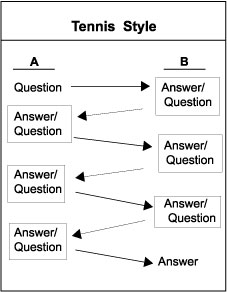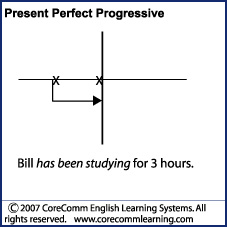 Tools for Students
Tools for Students
Easy Communication Tools
Here are some easy communication tools for you to use when speaking in English.
Remember to use simple easy words you know now.
Communication Dynamics
Speaking 'Bowling Style’ vs. 'Tennis Style'
With the CoreComm Learning System, students learn Core Communication skills and techniques. Students learn the skills they need to communicate with Anybody, Anywhere, and Anytime. As an example, let's look at 'Bowling Style' and 'Tennis Style' conversations.
Bowling Style Conversations
 Sadly, the 'Bowling' Style communication pattern is how many students speak English, even after studying English for a long time. When A asks B a question, B answers then stops. B expects A to continue asking questions. A often does. Then after A has asked all their questions on B's topic, B will begin asking questions about A's topic.
Sadly, the 'Bowling' Style communication pattern is how many students speak English, even after studying English for a long time. When A asks B a question, B answers then stops. B expects A to continue asking questions. A often does. Then after A has asked all their questions on B's topic, B will begin asking questions about A's topic.
This style of communication is one sided and not really interactive, and it is not the normal style of conversation or communication that native English speakers use. It does happen, but not all the time. This style can be been seen in some situations, for example when a police officer is talking to a speeding driver.
Police Officer: "How fast were you going?”
Speeding Driver:?"I don't know.”
Police Officer:“Show me your license. What's your name?”
Speeding Driver:?"Bob Johnson.”
Police Officer:“What's your address?”
Speeding Driver:“ 21 Maple Street”
This kind of conversation style isn't very interactive and it is not the normal style of conversation between native English speakers. Yet, many ESL lessons teach this style or they teach a few sentences that students are expected to memorize and use in certain situations- this is called the Communicative Language Approach or English For Special Purposes (ESP). Students when taking tests with listening sections, or when talking to other English speakers often have trouble in a normal conversation, because normal conversations are more interactive. Let's take a look at what a more usual English conversation looks like, the‘Tennis’style conversation.
 ‘Tennis Style' Conversations
‘Tennis Style' Conversations
'Tennis Style' conversations are often the more natural type of conversation that English speakers use. And this is the kind of conversation style that students are able to develop with the CoreComm Learning System. In the 'Tennis' style conversation, A asks B a question about A's topic. B answers the question, then B asks A a question on B's topic. This continues and often, both topics are talked about at the same time. This kind of conversation is found on many English tests (i.e. TOEIC™ or TOEFL™). And many students have trouble listening to this kind of question, they also have trouble listening and talking in conversations with native English speakers. Also, speakers may ask each other more than one question at the same time. So, normal conversations are a mixture of the 'Tennis' and 'Bowling' styles. This is one of the important core communication skills that students build with the CoreComm Learning System. The ability to use natural conversation styles, to be able to listen to and talk to Anybody, Anywhere, Anytime in Multiple Topic Environments (MTE).
Parts of Speech
| Part of Speech | Function | Example Words | Example Sentence |
|---|---|---|---|
| Verb | Action or State |
(to) be, have, do, like, work, sing, can, must |
English is a fun language to learn. I like the CoreComm Learning System to learn English. |
| Noun | Thing or Person |
pen, dog, work, music, city, Toronto, teacher, John |
This is my dog. He lives in his own dog house. |
| Adjective | Describes a Noun |
a/an, the, some, good, big, blue, well, interesting |
That is a big dog. Do you like big dogs? |
| Adverb | Describes a Verb, Adjective or Adverb |
quickly, silently, well, badly, very, really |
My dog runs quickly. When he is very happy, he runs really quickly. |
| Pronoun | Replaces a Noun |
I, you, he, she, some, they |
Hanako is Japanese. She is beautiful. |
| Preposition | Links a Noun to another word |
to, at, after, on, but |
They went to the office on Saturday. |
| Conjunction | Joins Clauses, Sentences or Words |
and, but, when |
I like tea and I like coffee. I like tea and coffee. I like tea but I don't like coffee. |
| Interjection | Short Exclamation, sometimes inserted into a sentence |
oh!, ouch!, hi!, well |
Ouch! That hurts! Hi! How are you? Well, I'm not sure. |
Verb Tenses
| Past | Present | Future |
|---|---|---|
 |
 |
 |
 |
 |
 |
 |
 |
 |
 |
 |
 |
Prepositions of Place & Time
Prepositions of Place
| Preposition | Use for | Examples |
|---|---|---|
| at | exact time/ place | 9:00 a.m./ one o'clock/ midnight/ at Yokohama Station/ at the office |
| on | exact date | Friday/ Friday, January 1st/ |
| in | time period | January/ the Spring/ |
Examples of Prepositions in Use:
- Let's meet at 9 am.
- Let's meet at 9 am, on Friday.
- Let's meet at 9 a.m., on Friday, April 7.
- Let's meet in 4 weeks, on Friday, 7 April.
- Let's meet in the Spring, on Friday, 7 April at my office.
Do you need to improve your communication skills now? Then contact CoreComm Learning Systems to schedule a course today.
Transitional Words & Phrases
| First | |
|---|---|
| Second | Then |
| And third | Next |
| After that | |
| Later | |
| And finally | |
Examples of Transition Words & Phrases
Transition words and phrases are very useful to connect your ideas and communicate them.
- First, go in the water. Second, put on your swim fins. And third, put on your diving mask and enjoy snorkeling.
- First, go in the water. Then, put on your swim fins. Next, put on your mask and enjoy snorkeling.
Do you need to improve your communication skills now? Then contact CoreComm Learning Systems to schedule a course today.
Adjective Order
| What the Adjective Describes | Examples |
|---|---|
| Quantity | two, three, a few, several, many |
| Value/ Opinion | delicious, wonderful, beautiful |
| Size | big, large, small, tall, short |
| Temperature | hot, warm, cool, cold |
| Age | new, young, old, 25 years old |
| Shape | triangle, square, round, flat |
| Colour | blue, red, green, yellow |
| Origin | Canadian, Japanese, |
| Material | steel, silk, wooden, plastic |
Examples of Multiple Adjective use
- There are three delicious chocolate cakes on the table.
- It's a large new house. It has three beautiful large bedrooms, and hardwood floors.
- She bought a beautiful old Japanese silk kimono.
- The last three days have been wonderful, warm and sunny.
How about you, would you like to improve your TOEIC score faster? Do you need to improve your communication skills now? Then contact CoreComm Learning Systems to schedule a course today.

CoreComm 92% Less Time
Students using the CoreComm Learning System were able to achieve, an average 1 point increase in their TOEIC scores in just 26 minutes compared to 150 minutes for students using TOEIC study materials. So, students were able to increase their scores in just 8% of the time, compared to the students who used TOEIC study methods, that's a 92% Time Savings. Using the CoreComm Learning System, students achieved their goals faster and saved an average of ¥1,000,000 compared to other methods. How about you, would you like to improve your TOEIC score faster? Do you need to improve your communication skills now? Then contact CoreComm Learning Systems to schedule a course today.
The CoreComm AAA Guarantee
Guaranteed!
The CoreComm Learning System using customized lessons, helps students clearly identify their weak areas in communication faster, target those areas with effective techniques and build their real core communication skills every lesson. With the CoreComm "AAA" Guarantee, students build their core global communication skills and confidence to talk to Anybody, Anywhere, Anytime. Guaranteed. Then contact CoreComm Learning Systems to schedule a course today.
